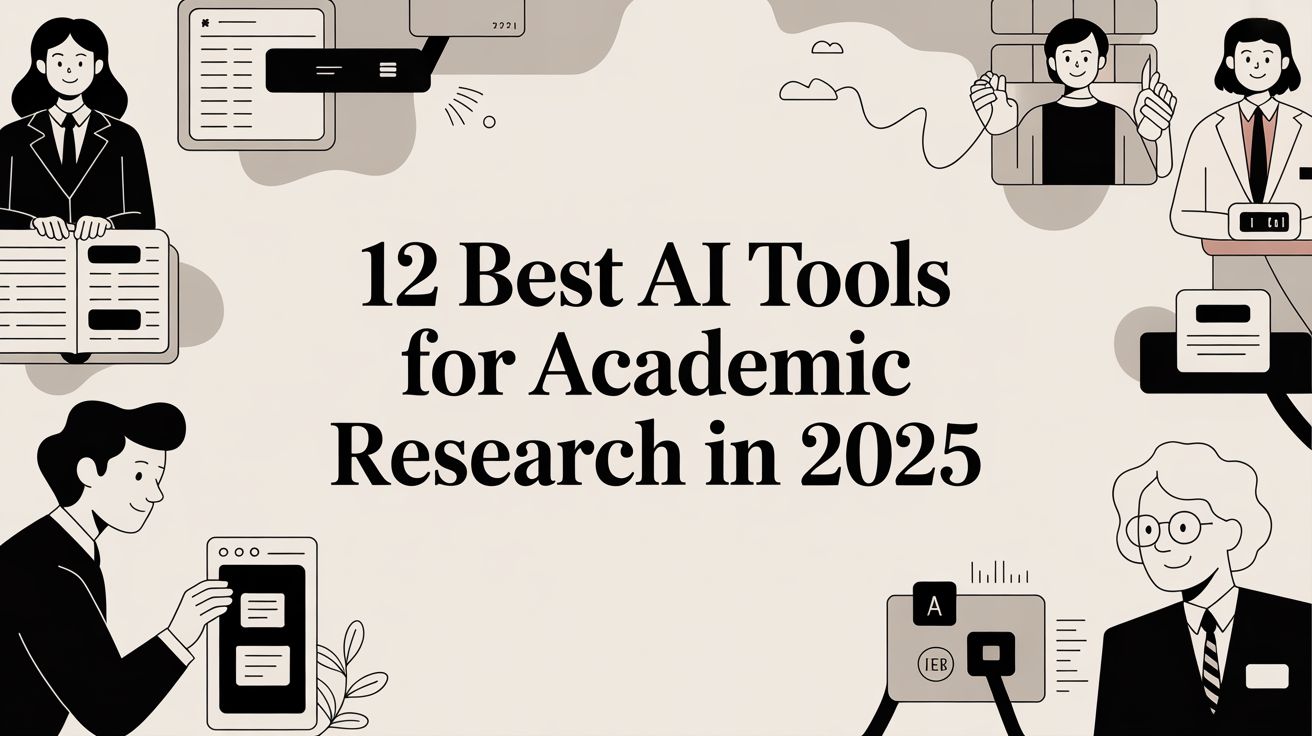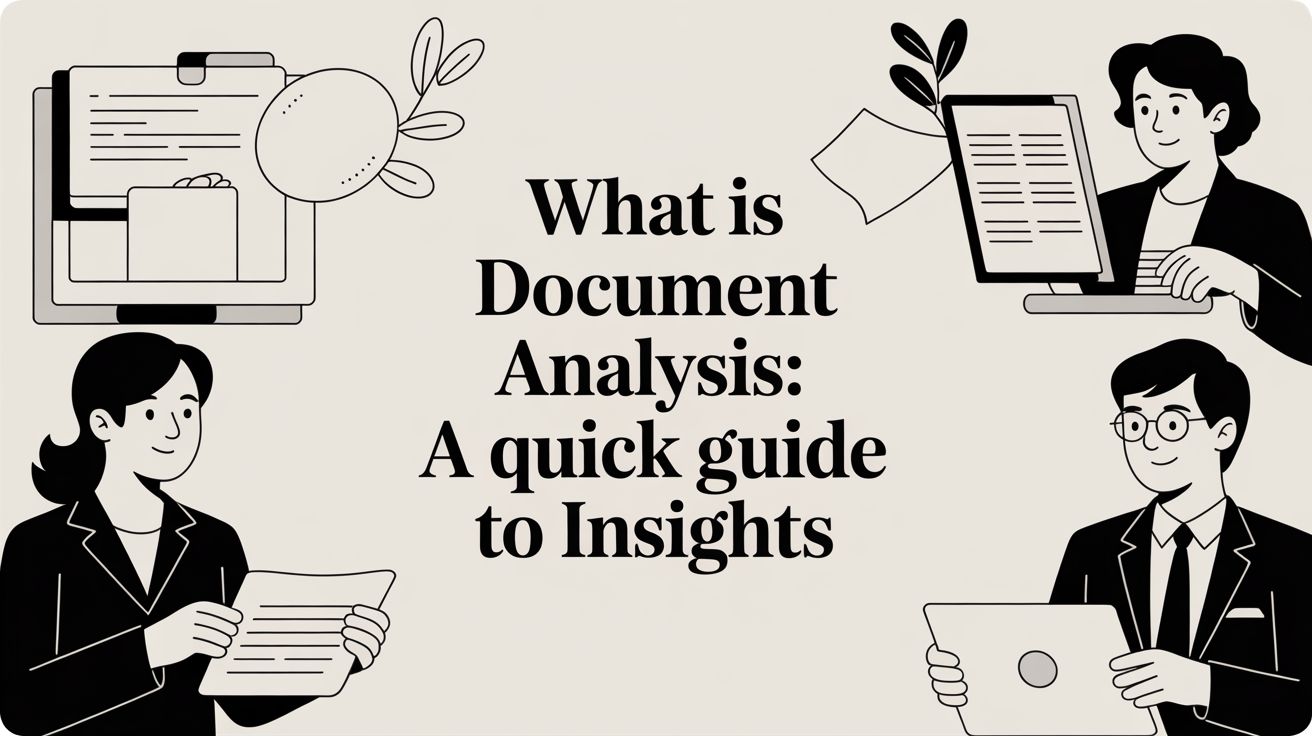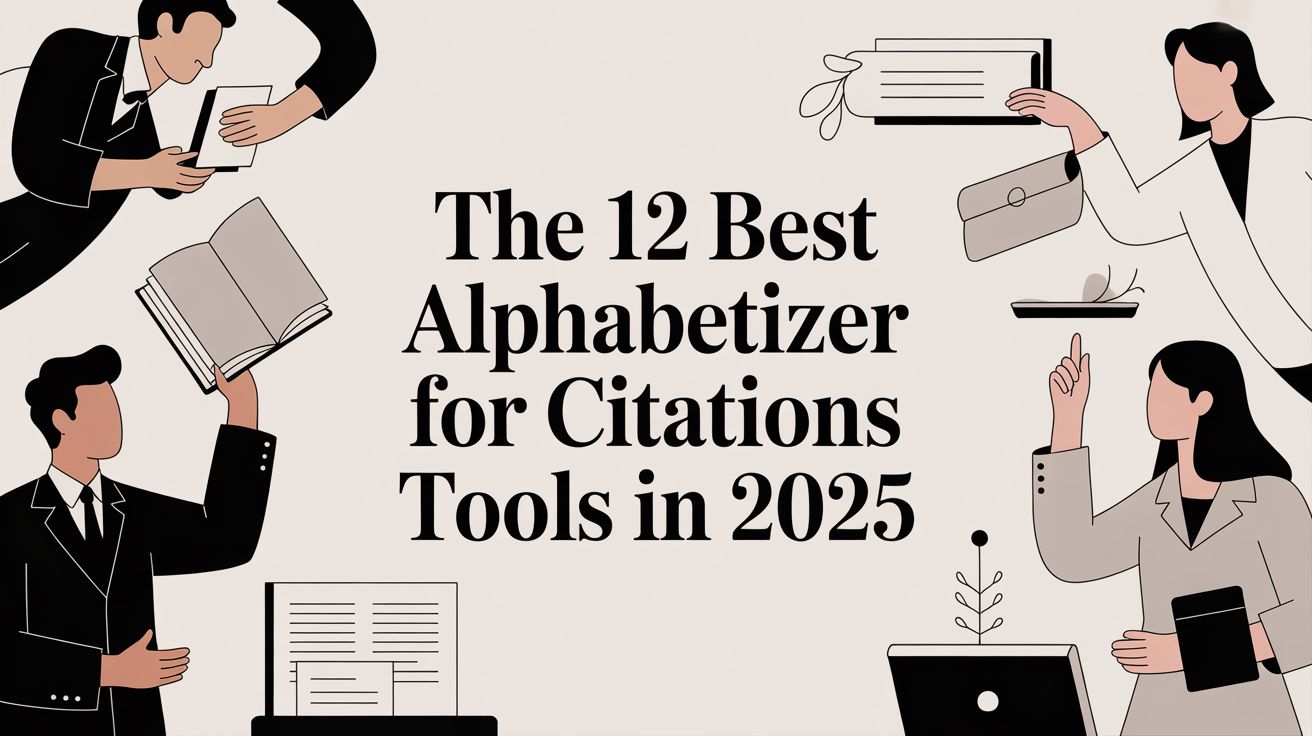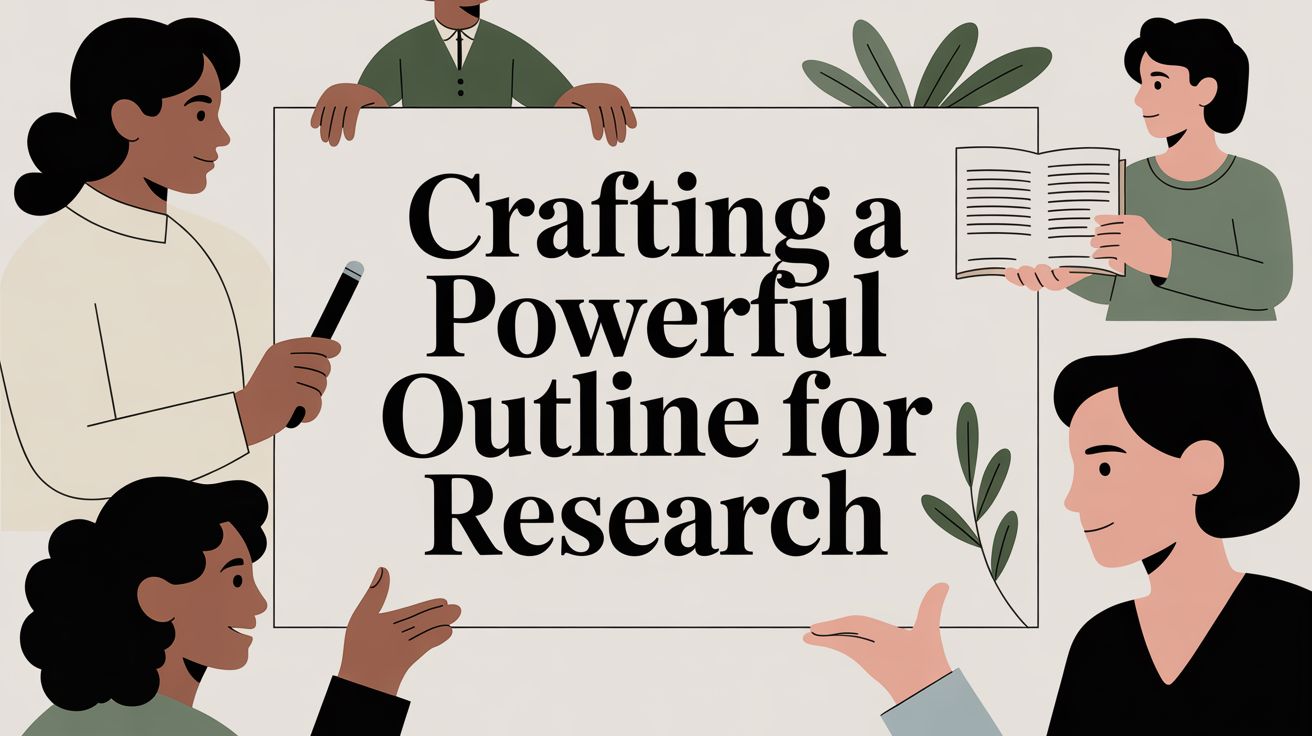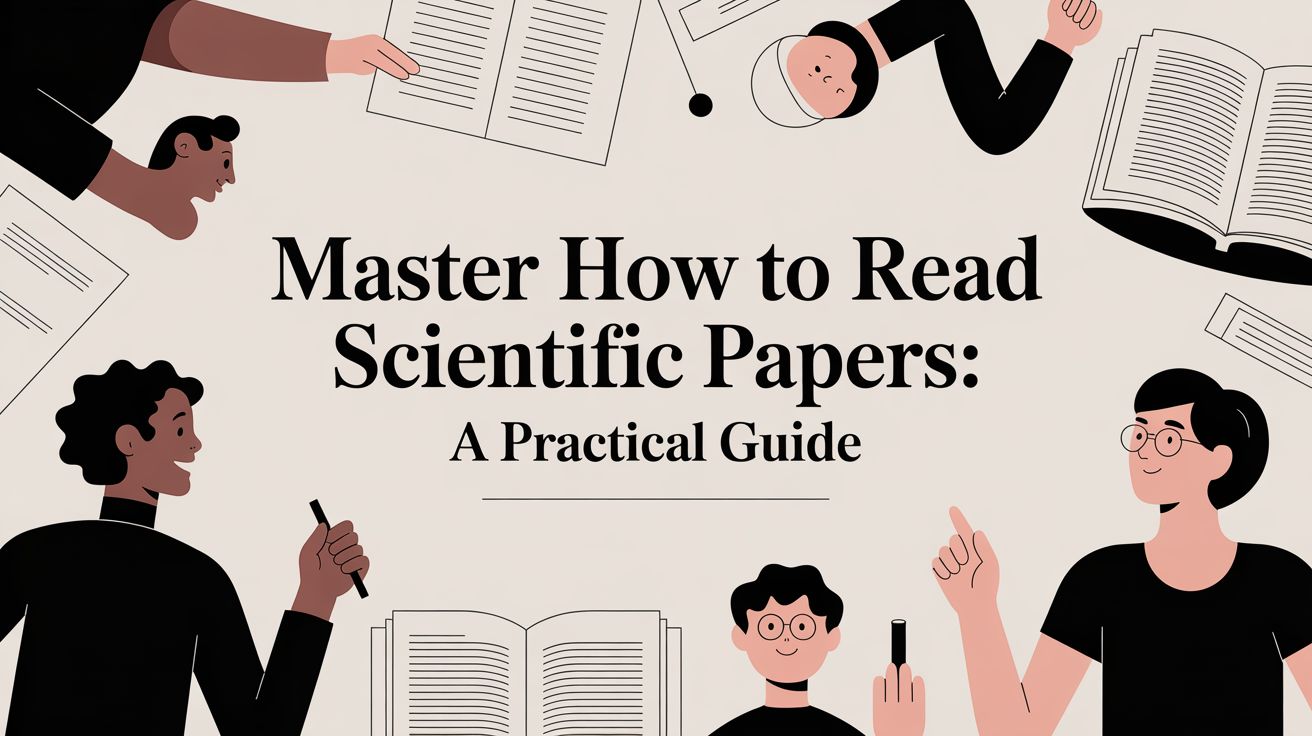How to conduct a literature review: a practical guide
Discover how to conduct a literature review with a practical, step-by-step guide covering scope, synthesis, and reporting findings.

Every great literature review starts not with a search, but with a question. Before you even think about diving into academic databases, the most critical work happens right at your desk. This initial planning phase is where you transform a vague interest into a sharp, focused research question and draw the boundaries for your entire project.
Get this part right, and you've built a solid foundation. Skip it, and you're setting yourself up for weeks of aimless searching, drowning in a sea of irrelevant papers.
Defining Your Scope and Research Question
Think of it this way: you wouldn't start a road trip without a destination. You’d pick a city, map the best route, and decide which stops are non-negotiable. Defining your scope is the academic version of that—it’s about turning a broad topic like "social media and mental health" into a question you can actually answer.

This planning stage is what separates a focused, insightful review from a sprawling, unfocused summary of everything ever written on a topic. It's your roadmap.
From Broad Topic to Focused Question
So how do you get from a general idea to a specific question? It’s all about refinement. You start broad and progressively add layers of detail until your inquiry becomes sharp and manageable.
A fantastic tool for this, borrowed from health sciences but useful everywhere, is the PICO framework:
- Population/Problem: Who or what is the subject? (e.g., University students, small businesses in the retail sector)
- Intervention/Interest: What’s the core concept you're looking at? (e.g., Use of mindfulness apps, adoption of AI for inventory management)
- Comparison/Control: What’s the alternative? (e.g., Traditional therapy, manual inventory methods)
- Outcome: What are you trying to measure or discover? (e.g., Reported changes in anxiety levels, impact on profit margins)
Applying this, our vague "social media and mental health" idea becomes something concrete: "Among university students (P), does daily Instagram use (I) compared to non-use (C) correlate with higher reported levels of anxiety (O)?"
See the difference? Now you have a question that gives your search direction and purpose.
Setting Your Inclusion and Exclusion Criteria
With a focused question in hand, the next step is to set the rules of the game. These are your inclusion and exclusion criteria—the specific parameters that dictate whether a source is in or out. This isn’t about being restrictive for no reason; it’s about ensuring every piece of literature you review is directly relevant to your question.
Your inclusion and exclusion criteria are your best defense against information overload. They act as a bouncer, letting in only the sources that belong and keeping your review tightly focused and on schedule.
Think about common boundaries you can set:
- Publication Date: Are you looking for the latest research from the last 5 years, or do you need a historical perspective that goes back decades?
- Study Type: Will you stick to peer-reviewed journal articles only? Or will you also consider book chapters, conference papers, or dissertations?
- Language: Is your search limited to English-language sources, or can you work with others?
- Geography: Does your question apply globally, or is it focused on a specific country, region, or culture?
Writing these rules down before you start your search is a game-changer. It forces you to be objective and consistent, making your final methodology much stronger and easier to defend.
To help you nail this crucial first step, here's a quick checklist to run through.
Literature Review Planning Checklist
This checklist is your pre-flight check before you launch into your search. Ticking these boxes ensures you have a clear plan, which will save you an incredible amount of time and frustration later on.
| Planning Stage | Key Action | Why It's Important |
|---|---|---|
| Topic Refinement | Go from a broad idea to a specific concept. | Prevents your topic from being too wide to cover effectively. |
| Research Question | Formulate a clear, answerable question (e.g., using PICO). | Provides a guiding "north star" for your entire search and analysis. |
| Define Scope | Set your inclusion/exclusion criteria. | Creates clear boundaries and keeps your review focused and manageable. |
| Identify Keywords | Brainstorm a preliminary list of search terms and synonyms. | Forms the basis of your search strategy in academic databases. |
| Select Databases | Choose the most relevant academic databases for your field. | Ensures you're searching where the most relevant literature lives. |
Going through this process methodically sets you up for a much smoother and more effective literature review.
The reality is, the field has become much more rigorous. Gone are the days of casual summaries; today, systematic reviews and bibliometric analysis are standard practice. In fact, research tracking 30 years of academic discourse on review methods identified 44 foundational papers that have shaped seven distinct frameworks for analysis. This just goes to show how much the expectations for precision have evolved. You can read the full research about these evolving methodologies to get a deeper sense of where the standards are today.
Building an Effective Search Strategy
Okay, you've nailed down your research question. Now it's time to roll up your sleeves and actually find the research. This is where a solid search strategy separates a great literature review from a mediocre one. It’s not about finding everything; it's about finding the right things.
Think of it like being a detective. Your research question is the case, and the academic papers are your evidence. A smart search strategy is your investigative plan, making sure you follow the most promising leads instead of getting bogged down in irrelevant details.

Crafting Precise Search Queries
The heart of your search is the "search string"—the specific combination of keywords and commands you feed into a database. Just typing your full research question into the search bar is a recipe for frustration. You have to break it down.
The secret lies in using Boolean operators. They look simple, but they're incredibly powerful tools for telling the database exactly what you want.
- AND: This makes your search more specific.
“mental health” AND “university students” AND “Instagram”will only pull up articles that discuss all three of those concepts. - OR: This broadens your search. It’s perfect for synonyms. For example,
“university students” OR “undergraduates” OR “college students”ensures you don't miss papers just because they used a different term. - NOT: This excludes terms. Be careful with this one, as it can easily backfire.
“social media” NOT “Facebook”might seem smart, but you'll toss out any relevant article that happens to mention Facebook, even in passing.
A huge rookie mistake is getting stuck on your initial keywords. The search process isn't a one-and-done deal. As you find good papers, look at the keywords the authors used. Steal them! Add them to your own search strings to uncover even more hidden gems.
Don't forget about truncation, either. Using an asterisk (*) can find different endings of a word. Searching for therap* will find therapy, therapist, therapies, and therapeutic all at once. It’s a huge time-saver.
Choosing the Right Databases
You wouldn't look for a needle in a haystack if you knew which part of the haystack was full of needles. The same goes for databases. While Google Scholar is a fantastic starting point, you absolutely need to dig into the specialized databases for your field.
Here's a quick rundown of some of the heavy hitters:
- PubMed: The bible for biomedical and life sciences.
- Scopus: A massive multidisciplinary database great for tracking who cited whom.
- Web of Science: Another giant, and particularly good for finding those foundational, game-changing papers.
- PsycINFO: If it's about psychology or behavioral sciences, it's in here.
- ERIC: The essential database for anything related to education research.
Mastering these tools is more critical than ever. A recent bibliometric study looked at 5,591 articles published between 2000 and 2023 and found a massive global surge in literature reviews. You can explore the full analysis on publication trends yourself. This isn't just a trend; it shows that conducting a rigorous, systematic search is a fundamental research skill in today's academic world.
Expanding Your Search with Snowballing
Even the most perfect search query will miss things. That’s where a technique called snowballing (or citation chasing) comes in. It’s surprisingly simple and effective.
Once you’ve found a handful of really key, highly relevant articles, you're sitting on a goldmine. Now, you dig into their reference lists.
This works in two directions:
- Backward snowballing: Go through the reference list of a great paper. This helps you find the foundational studies and historical context that shaped the research you're reading.
- Forward snowballing: Use the "Cited By" feature in databases like Google Scholar or Scopus. This shows you all the newer research that has built upon that key paper, bringing you right up to the present day.
By combining a systematic database search with the more organic process of snowballing, you get the best of both worlds. You'll have a comprehensive map of the conversation around your topic, from its earliest roots to the very latest findings.
Using AI Tools to Accelerate Your Analysis
You've executed your search strategy, and now you're sitting on a pile of promising sources. This is often where the real work begins—and where many researchers get bogged down. The sheer volume of dense academic papers can feel overwhelming, threatening to stop your momentum in its tracks.
This is the perfect time to work smarter, not harder. You don't have to manually read every word of every article just to see if it's relevant. Modern AI tools can give you a high-level overview in seconds, letting you quickly sort your sources and prioritize which ones deserve a deep, focused read.
Getting Instant Summaries of Dense Papers
The most straightforward way an AI tool can help is by generating a quick, concise summary. Think about it: you upload a 30-page study and, in less than a minute, get a clear, bulleted breakdown of its abstract, methods, findings, and conclusions.
This simple function completely changes the initial screening process. It allows you to:
- Quickly gauge relevance: You’ll know almost instantly if a paper actually addresses your research question before you invest hours reading it.
- Grasp the core argument: A good summary pulls out the main thesis, saving you the headache of digging it out of complex academic prose.
- Build your "must-read" list faster: By screening dozens of articles in the time it would take to read one, you can identify the most critical sources much more efficiently.
The idea isn't to skip the reading, but to make it far more strategic. If you're new to this approach, our guide on using a research paper summarizer offers a more detailed look at how to put it into practice.
Extracting Key Quotes with Citations
One of the most tedious parts of any literature review is manually typing out quotes and triple-checking that you’ve got the citation right. This is another area where AI can save you a massive amount of time.
You can simply ask the tool to find all statements related to a specific theme, and it will pull them for you—often with the page number and source information already attached. This is a huge time-saver and, just as importantly, it dramatically cuts down on the risk of transcription errors or misattribution.
This screenshot shows what a typical dashboard looks like. You upload your documents and just start asking questions.
The design is usually very intuitive. You drag and drop your PDFs and then use a simple chat prompt to ask for summaries, quotes, or analysis, making the whole process feel much less intimidating.
Asking Questions Across Your Entire Library
Now, here’s where these tools really shine. Instead of slogging through your sources one by one, you can combine multiple PDFs into a single "collection" and ask questions across all of them at once.
Imagine asking: "What are the main criticisms of Theory X across these 15 papers?" In seconds, the AI scans every document and synthesizes an answer, pointing you to the exact pages in each source where those criticisms appear.
This cross-document Q&A is incredibly powerful for the synthesis phase. You can use it to:
- Spot recurring themes: Ask, "What are the common methodological approaches used in these studies?" to see patterns emerge.
- Uncover contradictions: A prompt like, "Compare the findings of Author A and Author B on this topic," can instantly flag disagreements in the field.
- Find research gaps: By asking, "What questions remain unanswered across these articles?" you can get a direct line on where your own research can make a contribution.
This approach essentially turns your static pile of PDFs into a dynamic, searchable database built around your specific research question. If you’re looking to explore your options, this list of the top AI tools specifically designed for literature review is a great place to start. Adopting these tools lets you spend less time on manual data extraction and more time on what really matters: critical thinking, analysis, and building your argument.
Synthesizing Your Sources into a Cohesive Narrative
At this point, you've done the heavy lifting. You’ve wrangled databases, waded through abstracts, and your reference manager is probably looking pretty full. Now for the fun part—transforming that mountain of individual studies into a single, cohesive story.
A great literature review isn't just a list of who said what. It tells a story by weaving together different voices to reveal the bigger picture. This is where you move from simple summary to true synthesis.
Choosing Your Narrative Structure
Your first instinct might be to just lay everything out chronologically. While that can work, it's often not the most insightful approach. The best structure is one that serves your research question, guiding the reader through the literature to build a logical argument for your own work.
So, what story are your sources telling? Does the conversation unfold over time? Does it center on a few competing ideas? Or is it more about how different researchers have tried to tackle the same problem? Your answer will point you toward the right synthesis method.
AI-powered tools can make this process feel less overwhelming by helping you quickly summarize articles, pull key quotes, and even ask questions across your entire source library. It's a modern way to map out the conversation.
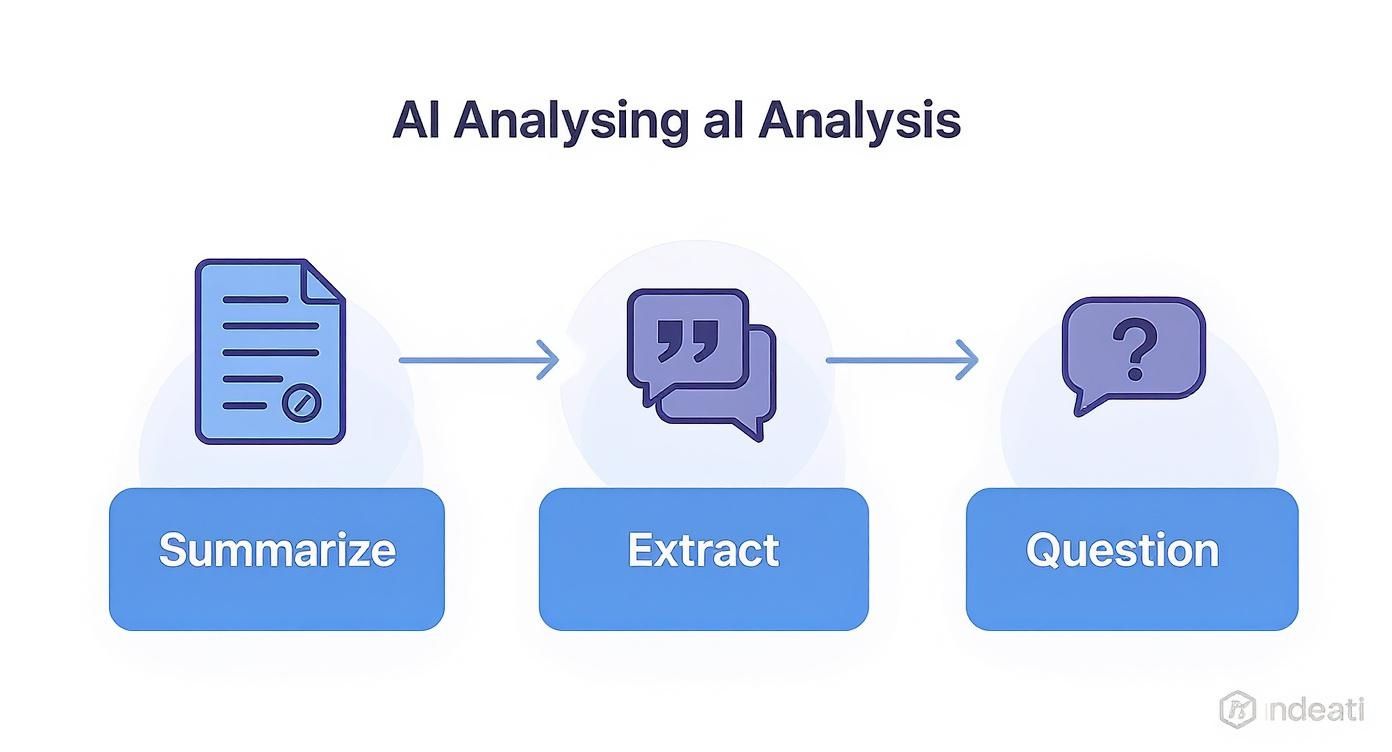
This visual shows how you can move from just gathering information (summarizing) to actively engaging with it (questioning), which is the heart of synthesis.
Common Synthesis Approaches
Let's look at the three most common structures for weaving your sources together. Each offers a different lens for viewing the scholarly conversation.
The choice of synthesis method is crucial as it shapes the narrative of your entire review. The table below breaks down the three primary approaches to help you decide which one best fits the story your sources are telling.
Choosing Your Synthesis Approach
| Synthesis Method | Best For... | Example Scenario |
|---|---|---|
| Thematic | Identifying the major themes, concepts, or debates that cut across multiple sources, regardless of when they were published. | Grouping studies on remote work by themes like "employee productivity," "work-life balance," and "organizational culture." |
| Chronological | Showing the evolution of a topic over time, highlighting how theories, methods, or consensus have changed. | Tracing the development of artificial intelligence in medical diagnostics from early rule-based systems in the 1980s to modern machine learning models. |
| Methodological | Comparing and contrasting the different research methods used to investigate a single topic. | Analyzing how researchers have studied childhood literacy, contrasting ethnographic studies, quantitative surveys, and experimental interventions. |
In my experience, the thematic approach is often the most powerful. It forces you to think beyond individual summaries and start identifying the core intellectual debates in your field. This is the essence of effective document analysis—finding patterns and relationships across a whole body of texts. You can read more about this in our guide on what document analysis is and how it's used in research.
From Notes to Narrative
Once you have a structure in mind, it's time to organize your notes. I'm a big fan of using a synthesis matrix, which is just a fancy name for a simple spreadsheet or table.
Create columns for your main themes and rows for each author or study. As you fill it in with your notes, you'll start to see a visual map of the conversation—who talks about what, and where they agree or disagree.
This simple exercise is fantastic for spotting connections, contradictions, and—most importantly—gaps. You might realize that while tons of studies discuss Theme A, almost none connect it to Theme B. Bingo. That connection could be the unique contribution your own research makes.
A literature review is an argument about the current state of knowledge. It doesn't just report what others have found; it organizes and evaluates that knowledge to make a point, identify a problem, or justify a new line of inquiry.
The sheer volume of modern research makes this task harder than ever. Big data analytics has changed the game, especially in fields like medicine. Between 2020 and 2025, a staggering 71.8% of medical big data literature focused on new applications. The USA led this charge, publishing 4,053 articles that earned a combined 159,464 citations.
To manage this flood of information, mastering good information summarization techniques is no longer a "nice-to-have" skill; it's essential for distilling findings into a coherent story.
Outlining Your Literature Review Structure
Finally, it's time to translate your matrix into a solid outline. A classic structure works best because it's clear and logical.
- Introduction: Start by explaining why the topic matters and what the review will cover. State your research question or the central problem your review is tackling.
- Body Paragraphs: This is the core of your review. Organize it by your chosen structure (thematic, chronological, or methodological). Each paragraph should focus on a single idea, synthesizing findings from multiple sources to show where scholars agree, disagree, or are still debating.
- Conclusion: Pull everything together by summarizing the key findings. Most importantly, this is where you highlight the gaps, unanswered questions, or limitations in the existing research. You're setting the stage for your own study, showing the reader exactly where your work fits into the conversation and why it's needed.
Writing and Refining Your Final Draft
You’ve done the heavy lifting—the searching, the reading, the synthesizing. Now it's time to translate all that work into a cohesive, polished draft. This is the moment where your own analysis and interpretation move to the forefront, turning your collection of notes into a compelling piece of academic writing.
This stage isn't about finding more sources; it's about finding your voice. A strong academic voice is clear, confident, and analytical. You’re not just summarizing the field—you’re crafting a narrative and presenting a clear argument about its current state and future direction.
From Reporting to Critical Analysis
The most common trap in writing a literature review is simply stringing together summaries of different studies. It reads like a list, not an argument. To avoid this, every single paragraph should be built around an idea, not an author.
Instead of writing, "Smith (2020) found X, and then Jones (2021) found Y," reframe it to focus on the conversation: "A key debate in the field centers on X, with scholars like Smith (2020) arguing for one perspective, while Jones (2021) offers a contrasting view based on Y." See the difference? The focus is on the debate, not just the authors.
To get into this mindset, constantly ask yourself these questions as you write:
- What are the strengths and weaknesses of this study's methodology?
- How does this author's conclusion confirm or challenge other work in the field?
- What are the underlying assumptions driving this particular line of research?
This approach shifts your role from reporter to expert guide. You are interpreting the academic landscape for your reader, not just pointing out landmarks.
Using Signposting to Guide Your Reader
A great literature review is effortless to follow. The reader should never feel lost or wonder why you’re suddenly discussing a particular study. The secret to this is signposting—using transitional phrases and sharp topic sentences to signal where your argument is headed.
Think of your draft as a journey. Signposts are the road signs that tell your reader what’s coming next, from "First, we will examine..." to "In contrast," or "A more recent perspective suggests..." These small phrases make a huge difference in readability.
Clear signposting creates a logical flow, weaving your introduction, body paragraphs, and conclusion into a seamless story. It's a simple but incredibly powerful technique for making your writing more persuasive and professional.
Managing Citations and Avoiding Plagiarism
As you pull in evidence from dozens of sources, meticulous citation is absolutely non-negotiable. Every claim you make about the literature must be backed up with a proper citation in a consistent style, whether it's APA (American Psychological Association), MLA (Modern Language Association), or another style specific to your field.
Trying to manage all those citations by hand is a surefire path to frustration and errors. This is where reference management software becomes indispensable.
- Zotero: A fantastic free, open-source tool that integrates with your browser and word processor. Perfect for getting started.
- Mendeley: Another popular free option with excellent PDF organization and annotation features.
- EndNote: A premium tool often provided by universities, known for its robust features and massive library of citation styles.
These tools will automatically format your in-text citations and build your bibliography, saving you countless hours and minimizing the risk of accidental plagiarism. They free you up to focus on the actual writing. For a deeper dive into structuring your research, check out our guide on creating an effective outline for research papers, which is a vital step before writing.
The Revision Process: Polishing Your Draft
Your first draft is never your final draft. It’s just the starting point. The real magic happens during revision. Once you've finished writing, step away from it for a day or two. When you return, you'll see it with fresh eyes.
Here’s a practical approach to revising your work:
- Argument and Structure: First, look at the big picture. Is there a clear, central argument? Does the overall structure logically support it? Try reading only the topic sentences of each paragraph—they should form a coherent summary of your entire review.
- Clarity and Flow: Next, focus on the language. Is it precise and easy to understand? Do your paragraphs transition smoothly from one to the next? Reading your work aloud is one of the best ways to catch awkward phrasing and clunky sentences.
- Proofreading: Only after you’re happy with the structure and flow should you zoom in on the details. Hunt down any spelling, grammar, and punctuation errors. Don't let a simple typo undermine your credibility.
Finally, never underestimate the value of a second opinion. Ask a trusted colleague, a mentor, or someone at your university's writing center to read your draft. A fresh pair of eyes will always catch things you missed, offering the invaluable perspective you need to turn a good draft into a great one.
Common Questions About Literature Reviews
Let's be honest: even with the best plan, the literature review process can throw some curveballs. You're not alone if you find yourself wrestling with a few key questions. Here are the answers to some of the most common hurdles I've seen researchers face over the years.
How Do I Know When I Have Read Enough?
Ah, the million-dollar question. There’s no magic number here. The real answer is when you hit a point of saturation.
You'll know you're getting close when you start seeing the same names, theories, and studies popping up over and over again. New articles you find don't really offer fresh insights; they just echo what you already know. You should be able to sketch out the main arguments and identify the key players in your field from memory.
A great sign you've reached this point is when you can read a new paper's abstract and accurately predict its main arguments and the authors it will cite. That’s when you know you've got a solid handle on the conversation.
The goal isn't to read every single thing ever published. It's about achieving comprehensive coverage of the relevant work.
What Is the Difference Between a Literature Review and an Annotated Bibliography?
This one trips up a lot of people. While they both involve reviewing sources, their purpose and structure are worlds apart. The easiest way to think about it is this: an annotated bibliography is a list, but a literature review tells a story.
An annotated bibliography is essentially a collection of citations. Each one is followed by a short, self-contained paragraph (the annotation) that summarizes and sometimes critiques the source. Every entry is its own little island.
A literature review, on the other hand, synthesizes all those islands into a cohesive narrative. It weaves together ideas from many sources to show how they connect, where they clash, and what bigger picture they create. You’re building a new argument out of existing work.
How Can I Avoid Just Summarizing Articles?
Moving from a simple summary to genuine analysis is what separates a great literature review from a mediocre one. The trick is to stop focusing on individual authors and start focusing on the ideas themselves.
Instead of writing a paragraph that says, "Smith (2020) found this..." followed by "Jones (2021) argued that...", try structuring your paragraphs around a central theme or debate. For instance, you could have a whole section on a particular methodology, discussing how several different researchers have applied or criticized it.
Use language that forces you to compare and contrast, putting your sources into a direct conversation:
- "While Smith's findings suggest X, Jones offers a contrasting view..."
- "Harris builds on this foundational work by..."
- "Both studies agree on the core problem, but they diverge significantly in their proposed solutions..."
Most importantly, always tie everything back to your research question. Why does this particular study matter for what you're trying to do? Critically engaging with the material in the context of your own work is the key.
What Are the Most Common Mistakes to Avoid?
I've seen the same handful of mistakes derail otherwise promising literature reviews time and time again. If you know what they are from the start, you can sidestep them completely.
Watch out for these common pitfalls:
- No clear research question: This is the big one. Without a guiding question, your review will feel aimless and unfocused.
- Leaning too heavily on secondary sources: Don't just read other people's reviews or textbooks. Get to the primary research articles yourself.
- Taking findings at face value: A good review doesn't just accept an author's conclusions. It questions their methodology, looks for bias, and evaluates the evidence.
- A "laundry list" structure: This happens when you just summarize one paper after another without creating a cohesive argument.
- Sloppy citations: Inconsistent formatting or, even worse, accidental plagiarism from poor note-taking can seriously undermine your credibility.
Ready to conquer that pile of research papers? PDF Summarizer lets you upload multiple documents, ask questions across your entire library, and pull out key insights with citations in seconds. Stop drowning in text and start synthesizing faster. Give PDF Summarizer a try for free today and see how it can speed up your literature review.
Relevant articles
Discover the best AI tools for academic research. Our curated list covers literature reviews, data extraction, writing, and summarization to speed up your work.
What is document analysis: Discover the methods, real-world examples, and a clear step-by-step approach to extract insights from documents.
Discover the top 12 tools to streamline your writing. Find the perfect alphabetizer for citations to create flawless reference lists effortlessly.
Discover how a research paper summarizer uses AI to distill key insights from dense texts. Learn how these tools work and how to use them effectively.
Learn how to create a powerful outline for research that streamlines your writing process. Get practical tips and examples for any academic paper or thesis.
How to read scientific papers: Learn planning, annotation, and critical appraisal to extract actionable insights and improve your research outcomes.
